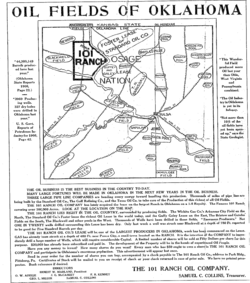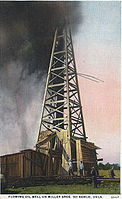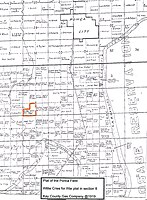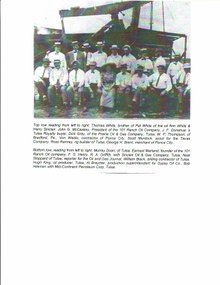
Marland is a town in Noble County, Oklahoma, United States. The population was 225 at the 2010 census. It was named for Ernest W. Marland, an oilman from nearby Ponca City who later became a governor of Oklahoma. Marland is on SH-156, south-southwest of Ponca City.

Ponca City is a city in Kay County in the U.S. state of Oklahoma. The city was named after the Ponca tribe. Ponca City had a population of 24,424 in the 2020 census, down from 25,387 at the time of the 2010 census.
ConocoPhillips Company is an American multinational corporation engaged in hydrocarbon exploration and production. It is based in the Energy Corridor district of Houston, Texas.

Phillips Petroleum Company was an American oil company incorporated in 1917 that expanded into petroleum refining, marketing and transportation, natural gas gathering and the chemicals sectors. It was Phillips Petroleum that first found oil in the North Sea on December 23, 1969, at a position that was later named Ekofisk.

Ernest Whitworth Marland was an American lawyer, oil businessman in Pennsylvania and Oklahoma, and politician who was a U.S. representative and Oklahoma governor. He served in the United States House of Representatives from northern Oklahoma, 1933 to 1935 and as the tenth governor of Oklahoma from 1935 to 1939. As a Democrat, he initiated a "Little Deal" in Oklahoma during the Great Depression, working to relieve the distress of unemployed people in the state, and to build infrastructure as investment for the future.
Lydie Marland, an American socialite, was born Lyde Miller Roberts in Flourtown, Pennsylvania, the second child of Margaret Reynolds (Collins) and George Frederick Roberts. Her parents decided to give up her and her brother for adoption as teenagers by their maternal aunt and uncle, Virginia and Ernest Whitworth Marland, who were both childless and fabulously wealthy from his success in the oil business in Ponca City, Oklahoma.
Conoco is an American petroleum brand that is operating under the ownership of the Phillips 66 Company since 2012 and is headquartered in Houston, Texas. One of the several successors of Standard Oil, Conoco was a subsidiary of that company from 1884 until its 1911 divestiture when the U.S. Supreme Court ruled to decouple the monopolized entity.

Marland Oil Company was an American integrated petroleum company that existed from 1921 to 1929. The company was founded by Ernest Whitworth Marland (1874–1941) and was based in Ponca City, Oklahoma.
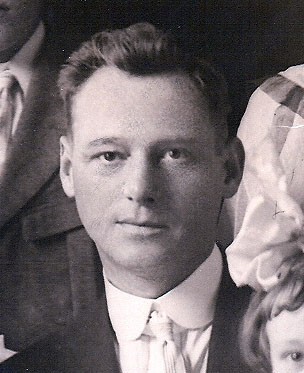
John Gruard McCaskey was an American oil businessman.

William Hartman McFadden was an American businessman and an essential factor in opening up the oil fields of Oklahoma.

Lewis Haines Wentz was an American oil businessman.

Woolaroc is a museum and wildlife preserve located in the Osage Hills of Northeastern Oklahoma on Oklahoma State Highway 123 about 12 mi (19 km) southwest of Bartlesville, Oklahoma, and 45 mi (72 km) north of Tulsa, Oklahoma. Woolaroc was established in 1925 as the ranch retreat of oilman Frank Phillips. The ranch is a 3,700-acre (1,500 ha) wildlife preserve, home to over 30 different species of native and exotic wildlife, such as bison, elk and longhorn cattle. Woolaroc is also a museum with a collection of Western art and artifacts, American Indian material, and one of the largest collections of Colt firearms in the world. Also on display is Woolaroc, the aircraft that won the ill-fated Dole Air Race in 1927. Woolaroc features a nature trail and a living history area inviting visitors to experience the natural environment of Woolaroc, the life in a pre-Civil War 1840s mountain man camp.
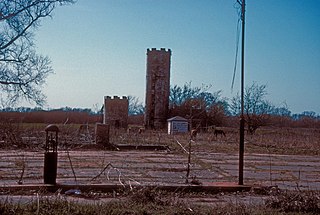
The Miller Brothers 101 Ranch was a 110,000-acre (45,000 ha) cattle ranch in the Indian Territory of Oklahoma before statehood. Located near modern-day Ponca City, it was founded by Colonel George Washington Miller, a veteran of the Confederate Army, in 1893. The 101 Ranch was the birthplace of the 101 Ranch Wild West Show and one of the early focal points of the oil rush in northeastern Oklahoma. It was the largest diversified farm and ranch in America at the time. Bill Pickett's grave and the White Eagle Monument are located on the ranch grounds. The location of the former working cattle ranch was subdivided and all of its buildings destroyed. An 82-acre (33 ha) area of the ranch is a National Historic Landmark. In 2003, the ranch was inducted into the Texas Trail of Fame.

The E.W. Marland Mansion is a 43,561 square feet (4,046.9 m2) Mediterranean Revival-style mansion located in Ponca City, Oklahoma, United States. Built by oil baron and philanthropist Ernest Whitworth (E.W.) Marland, as a display of wealth at the peak of the 1920s oil boom, the house is one of the largest residences in the southwestern United States, and is known as the "Palace on the Prairie." It was designated a National Historic Landmark in 1973, and is now a museum open to the public.
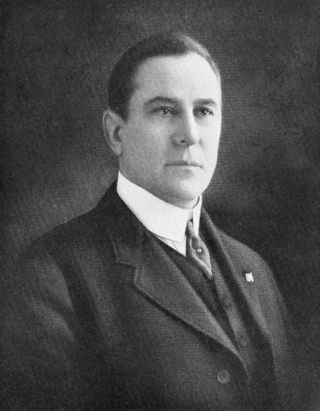
Solomon Andrew Layton was an American architect who designed over 100 public buildings in the Oklahoma City, Oklahoma area and was part of the Layton & Forsyth firm. Layton headed partnerships in Oklahoma from 1902 to 1943; his works included the Canadian County Jail in El Reno, Oklahoma State Capitol, sixteen Oklahoma courthouses, and several buildings on the University of Oklahoma campus. Layton had a considerable influence on the area's architecture, and he became known as the "dean of Oklahoma City architecture".
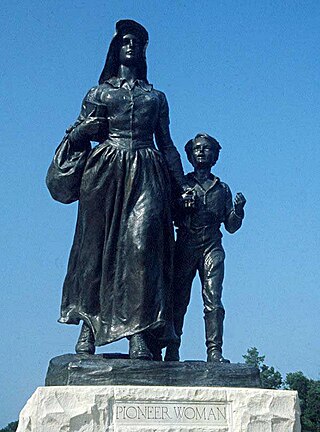
The Pioneer Woman monument is a bronze sculpture in Ponca City, Oklahoma, designed by Bryant Baker and dedicated on April 22, 1930. The statue is of a sunbonneted woman leading a child by the hand. It was donated to the State of Oklahoma by millionaire oilman E. W. Marland. He commissioned models from twelve well-known sculptors and financed a nationwide tour to get feedback from art critics and the general public in order to decide which model to use for the final statue.

Hudson's Bay Oil and Gas Company Limited was a Canadian non-integrated petroleum company that operated between 1926 and 1982. Originally called the Hudson's Bay Marland Oil Company (HBMOC), it was founded as a joint venture between the Hudson's Bay Company and the Marland Oil Company with the purpose of producing oil on land where the HBC held mineral rights. In 1929 the Continental Oil Company (Conoco) purchased Marland Oil and reformed the HBMOC as the Hudson's Bay Oil and Gas Company (HBOG). By the 1960s HBOG had become the third largest oil producer in Canada. Between 1981 and 1982, Dome Petroleum, also based in Calgary, acquired HBOG for $4 billion in what was then the most expensive takeover in Canadian history. The purchase by Dome ultimately contributed to its own demise in 1988, at which time it was acquired by Amoco Canada.

The Marland Grand Home is listed on the National Register of Historic Places. The Grand Home is the first home built by Oklahoma Oilman E. W. Marland in Ponca City, Oklahoma and is considered a landmark in the community. The Grand Home was given its name because the home is on Grand Avenue in Ponca City, the community where Marland lived from 1908 until his death in 1941 and the city where he founded the Marland Oil Company and where he built his Ponca City oil refinery, still in operation today more than 100 years later. Marland's Grand Home is a 1910s period mansion built in the Italian Renaissance Revival style. The Grand Home is owned by the City of Ponca City and includes exhibit rooms for Miller Brothers 101 Ranch history, Native American archaeology, artifacts and art, and Daughters of the American Revolution exhibits. The Grand Home was formerly known as the Ponca City Cultural Center Museum.

Daniel James Moran an American oilman who served as a senior officer with Texaco, Marland Oil, and Continental Oil. Moran was the first President of Conoco oil company. After E. W. Marland lost control of Marland Oil Company to J. P. Morgan in 1928, Moran was brought in as the new president. Moran successfully acquired Continental Oil Company and merged it with Marland Oil creating a new company called Conoco. Moran ran Conoco from 1928 to 1947 and saw the company successfully through the great depression and World War II. Under Moran's leadership, Conoco became a pioneer in offshore drilling, continental pipelines, petrochemicals, and aviation fuel.

Following the 1911 Supreme Court ruling that found Standard Oil was an illegal monopoly, the company was broken up into 34 different entities, divided primarily by region and activity. Many of these companies later became part of the Seven Sisters, which dominated global petroleum production in the 20th century, and became a majority of today's largest investor-owned oil companies, with most tracing their roots back to Standard Oil. Some descendants of Standard Oil were also given exclusive rights to the Standard Oil name.
